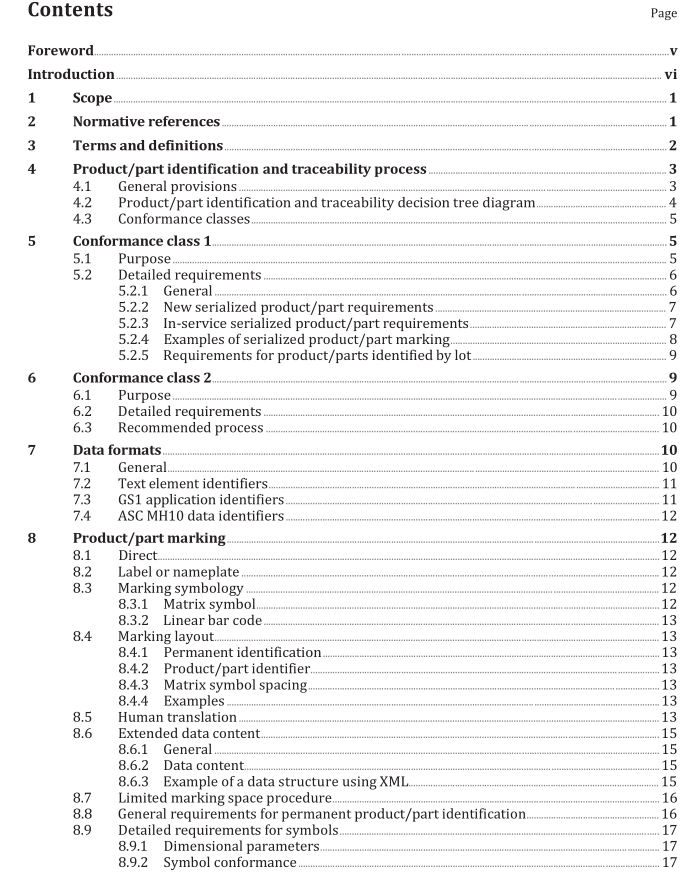ISO 21849 pdf download

ISO 21849 pdf download Aircraft and space — Industrial data — Product identification and traceability
4.3 Conformance classes Permanent machine-readable media product/part identification has two approaches to the representation of data, known as conformance classes. The conformance classes shall apply to direct part marking, labels, nameplates, RFID tags and other forms of machine-readable media. The data elements associated with the two conformance classes are specified in Tables 1 and 2 . Any stream of data complying with a conformance class specified in Table 1 or Table 2 may be input to product life cycle processes and be represented in machine-readable media. Conformance class 1 is the approach using only specified TEI data elements. Using specified well- defined data elements minimizes transmission, storage and retrieval times. Trading partners may agree on adding additional traceability data elements. conformance class 1 is intended for those products/ parts which require life cycle traceability for decades; for example, industrial products like aircraft, ships, turbine engines and conveyance power generation equipment. Conformance class 2 provides a more flexible approach which can require more marking space and time to exchange data than conformance class 1. Conformance class 2 provides examples of product/ part identifiers to be used in place of the precisely defined standardized data elements in conformance class 1. Conformance class 2 is intended for use by trading partners who have product/part identifiers already in place, for which a business case cannot be made to change to conformance class 1 specific identification requirements. Trading partners shall agree on the product/part identifiers to be used for conformance class 2 and may agree on additional data elements. Trading partners need to agree on which conformance class to employ in order to obtain interoperability between multiple users, but conformance class 1 shall be the default if no agreement is in place.
5 Conformance class 1
5.1 Purpose Conformance class 1 is an approach using only specified TEI data elements for product identification. It provides both for the identification of products and parts that are serialized and for the identification of those that are identified by lot.
5.2.2 New serialized product/part requirements5.2.2.1 Required data elements
For a new product/part, the following data elements are required.
a) Permanent unique identification of the product/part throughout its life, in a matrix symbol, or on a
data plate/label, or in an RFID tag. This shall consist of
1) an enterprise identifier for the manufacturer(CAG,DUN or EUC)(see A.1,A.3-and A.4),followed
by
2)a unique product/part serial number (SER) (see A.7).
When using CAGE/NCAGE as the enterprise identifier, space may be saved by using a combined element.The combined element TEl is USN (see A.8).
b) Current product/part identifier (PNR)(See A.2). This data element shall be in a second matrix
symbol or data plate/label to easily allow for necessary changes over the life of the part (seeFigures 2-b) and 3-b) for examples).
The unique product/part serial number shall be a unique number within the manufacturer’s enterpriseidentifier. The unique product/part serial number shall remain constant during the life of the product/part, even if the current product/part identifier is changed due to a form, fit or function change.Onlythe original manufacturer shall use the unique product/part serial number. All others shall use theunique component identification number (UcN) (see A.6).
NOTE Annexes D and E-identify the equivalent application identifiers and data identifiers to use in theproduct/part identification schema defined in this document.
5.2.2.2Optional traceability data elements
The optional traceability data elements shall be agreed between trading partners. When matrixsymbols are being used, the optional traceability data elements shall be contained in a separate matrixsymbol, i.e. a third symbol, additional to those provided for by 5.2.2.1 a) and b).For an RFID tag, thetraceability data elements shall follow the essential data elements.Refer to Table 1, footnoteB for theorder of preference when selecting traceability data elements.
5.2.3 In-service serialized product/part requirements
For a serialized product/part that is already in service, the current product/part owner should firstcontact the original manufacturer to determine if the company will provide a unique product/partserial number within their appropriate enterprise identifier. If agreement is obtained,the requirementsspecified in 5.2.2-apply. If an agreement cannot be obtained from the original manufacturer, or theoriginal manufacturer is out of business, the data elements listed below shall be applied.Either thecombination of the original manufacturer’s enterprise identifier and unique product/part serialnumber or the current owner’s enterprise identifier and unique component identification number shallbe the permanent identification for an in-service serialized product/part.









